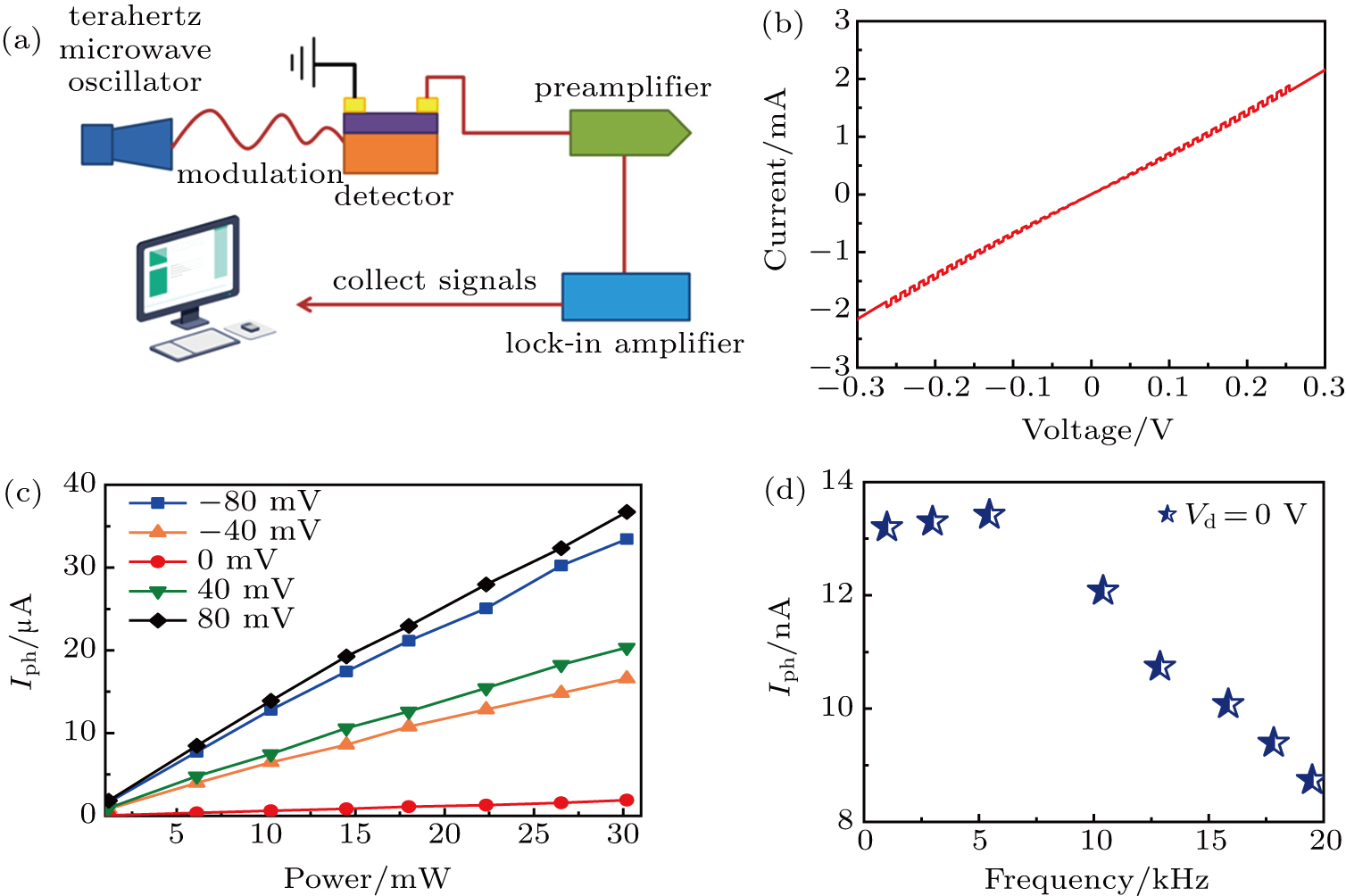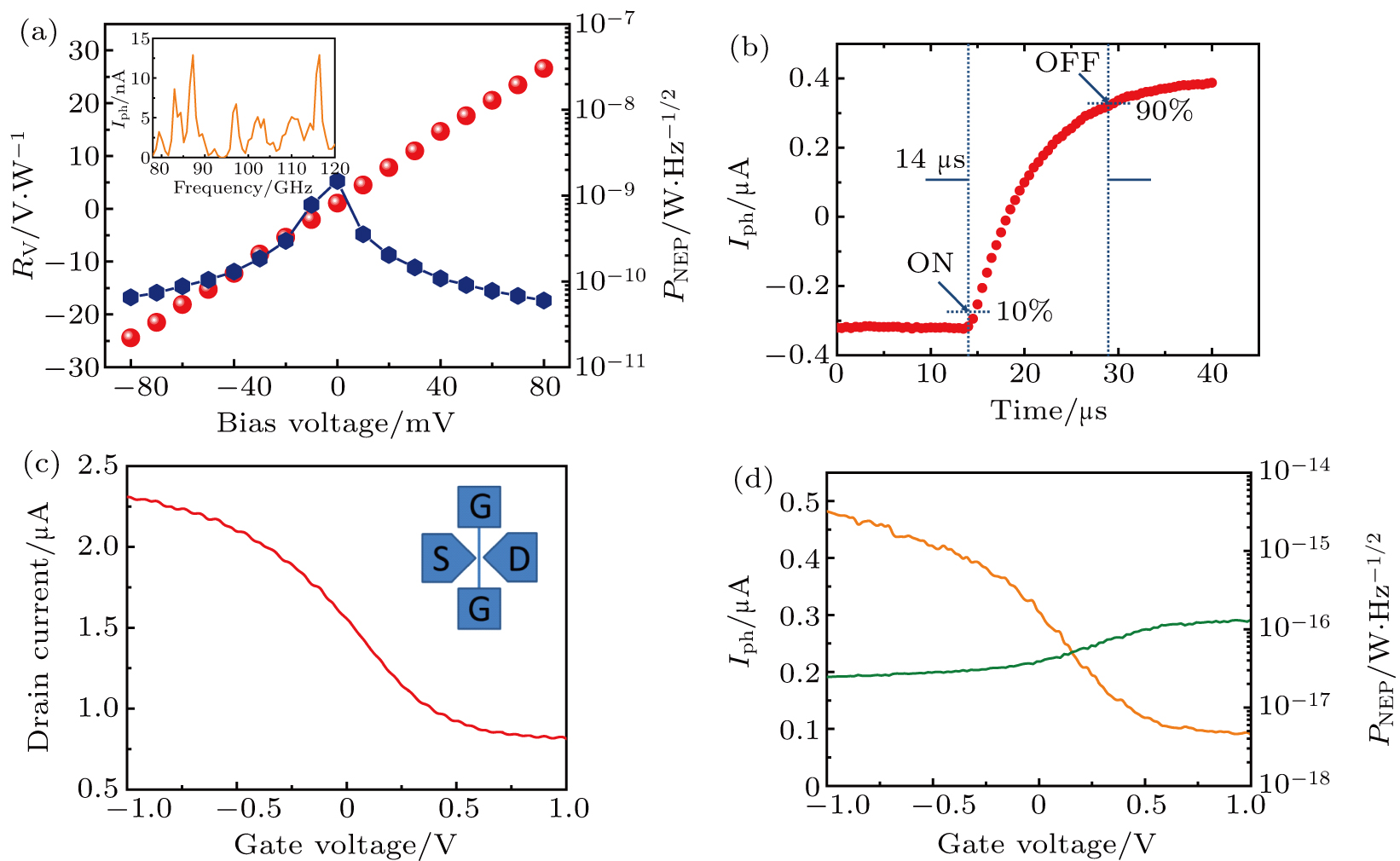† Corresponding author. E-mail:
Two-dimensional transition metal dichalcogenides (TMDs) provide fertile ground to study the interplay between dimensionality and electronic properties because they exhibit a variety of electronic phases, such as semiconducting, superconducting, charge density waves (CDW) states, and other unconventional physical properties. Compared with other classical TMDs, such as Mott insulator 1T–TaS2 or superconducting 2H–NbSe2, bulk 2H–TaSe2 has been a canonical system and a touchstone for modeling the CDW measurement with a less complex phase diagram. In contrast to ordinary semiconductors that have only single-particle excitations, CDW can have collective excitation and carry current in a collective fashion. However, manipulating this collective condensation of these intriguing systems for device applications has not been explored. Here, the CDW-induced collective driven of non-equilibrium carriers in a field-effect transistor has been demonstrated for the sensitive photodetection at the highly-pursuit terahertz band. We show that the 2H–TaSe2-based photodetector exhibits a fast photoresponse, as short as 
The terahertz band, which is loosely defined as the electromagnetic frequency ranged from 0.1 THz to 10 THz, has found many unique properties, such as highly penetrable to non-metallic/polar materials, non-invasive due to its low energy, and especially commensurate with spectroscopic region of rotational and vibration modes of many biomedical molecules. Therefore, THz techniques have recently received considerable interest in the the study of biodetection,[1] stand-off spectroscopy for security screening,[2–4] space-based observatory,[5,6] and many other fields. Despite the vast amount of promising applications, generation and detection at THz band is limited by the development of microwave and infrared technology.
To convert THz light into an electrical signal, a series of methods have been delineated within the capability of satisfying peculiar circumstances. Typically, the direct detection of the thermal radiation within the so-called thermal detectors in the forms of the bolometer,[7] pyroelectric detector,[8] and Golay cell have been historically rendered as classical schemes with continuous achievements thanks to the progress of material science and nanotechnology. Principally, for a thermal-based detector, the incident radiation is absorbed to change the material temperature. The resultant change in some physical property is used to generate electrical output. In pyroelectric detectors, a change in the internal electrical polarization is measured, whereas in the case of bolometer a change in the electrical resistance is measured. However, deep cryogenic-cooling or even refrigeration cooling at temperature below 4.2 K is needed in the state-of-art thermal-based detector, suffering from a slow response time (at about 
Field-effect transistors (FETs) host a two-dimensional electron gas with high electron mobility and have proven to be potential candidates for room temperature applications due to their high sensitivity, low noise and simplicity of integration.[9,10] A field effect transistor with nanometer length gate can support collective electron oscillation-plasma wave, which is similar with other electronic-based devices, producing nonlinear rectification of THz field. The appearance of van der Waals materials, such as graphene and transition metal dichalcogenides (TMDs) offers new opportunities as groundbreaking materials with extraordinary optoelectronic properties that allow unprecedented integration of two-dimensional channel with ultrahigh mobility with the aim of both plasma waves and photothermoelectric THz detection at room temperature.[11] A recent study has shown that cooperative behavior in TMDs caused by the condensate of strong correlated interaction can be controlled either electrically or optically, offering substantiate routes to build suitable principle for THz detection. Unlike the plasma wave effect, charge density waves, as an alternate collective order of electronic reconstruction caused by the periodic lattice distortion under strong electron–phonon coupling, can carry a charge current in a collective fashion. Therefore, the complete control of such many-body state will revolutionize photon absorption and its energy conversion. Among such materials, the 2H–TaSe2 could be a canonical system due to its clear phase diagram in the absence of compete from superconducting transition and Mott state.[12] This material exhibits normal metallic state at room temperature, and a second-order near commensurate ordered phase at 122 K, with the capability of overcoming the bottleneck of higher temperature operation in thermal detectors. In this work, we show on multilayer transistors, with 2H–TaSe2 as the active channel, displaying a rapid response time and relative high responsivity at THz band. The results of the proposed charge density wave transistors can be further optimized to meet the practical applications of high-performance photodetectors and represent an important guide to explore many-body states for the next generation of condensed matter research and device application.
In this experiment, multilayer 2H–TaSe2 were mechanically exfoliated from bulk counterpart and transferred by using a scotch-tape method onto the Si/SiO2 wafer, which is covered by a dox = 285 nm thick thermally grown oxide layer. The channels were defined by oxygen plasma etching followed by ultraviolet (UV) lithography and electron-beam evaporation process with Cr/Au stack (8-nm Cr and 65-nm Au) to form the drain and source electrodes after lift-off. The optical microscopic and atomic force microscope (AFM) images of the fabricated TaSe2 field effect transistor (FETs) is shown in Figs. 
A cross-sectional view of the 2H–TaSe2 FET and its electrical connections is shown in Fig. 
To elucidate more clearly the performance of CDW device, the voltage/current responsivity is calculated with the following relationship:[14]

| Table 1.
Performance parameters of some terahertz detectors. . |
To fully assess the sensitivity of the detector, noise equivalent power (PNEP) extracted from the ratio VN/RV is another important quality factor. It has been assumed that the main contribution of the noise figure is the thermal Johnson–Nyquist noise (Nth), and VN is described by the following equation:[14]
In addition to the sensitivity, the response time is also crucial to practical applications. Therefore, the time resolved photocurrent was also measured, as shown in Fig. 
Furthermore, it has been reported previously that top-gated configurations are critical for suppressing Coulomb scattering in TMDs (e.g., MoS2) channels, which can be useful for low-power operation, as well as the feasibility for tuning the electronic and optoelectronics properties.[21–23] Especially, recent studies have revealed the essential role of electrostatic doping in tuning the strong correlation interaction in TMDs due to their two-dimensional nature, opening up the possibility in uncovering intriguing phenomena of condensed matter physics and device applications. To better understand the role of gating effect, we have also tried to prepare the top gate configuration in order to tuning the absorption and conductivity of 2H–TaSe2 within a few additional processing steps. On the basis of above-mentioned MSM structure, a 30-nm Al2O3 layer was deposited as a dielectric layer on 2H–TaSe2 through atomic layer deposition (ALD) at about 300 °C, and the gate fingers are aligned by electron–beam lithography. It can be found from Fig. 

In summary, we have achieved a room temperature photodetector with a fast response in a 2H–TaSe2-based terahertz system. By integrating with a logarithmic antenna, the responsivity exceeds 27 V/W and the response time can reach 
| [1] | |
| [2] | |
| [3] | |
| [4] | |
| [5] | |
| [6] | |
| [7] | |
| [8] | |
| [9] | |
| [10] | |
| [11] | |
| [12] | |
| [13] | |
| [14] | |
| [15] | |
| [16] | |
| [17] | |
| [18] | |
| [19] | |
| [20] | |
| [21] | |
| [22] | |
| [23] | |
| [24] |




